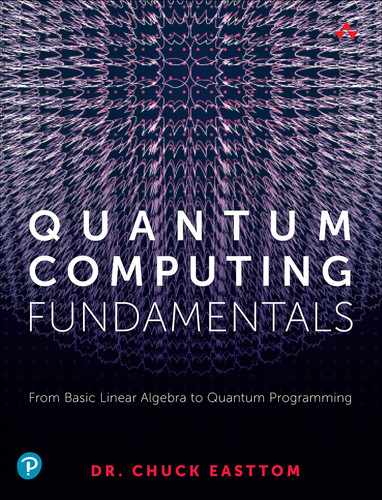ONE-VOLUME INTRODUCTION TO QUANTUM COMPUTING Clearly explains core concepts, terminology, and techniques Covers the foundational physics, math, and information theory you need Provides hands-on practice with quantum programming The perfect beginners guide for anyone interested in a quantum computing career Dr. Chuck Easttom brings together complete coverage of basic quantum computing concepts, terminology, and issues, along with key skills to get you started. Drawing on 30+ years as a computer science instructor, consultant, and researcher, Easttom demystifies the fields underlying technical concepts and math, shows how quantum computing systems are designed and built, explains their implications for cyber security, and previews advances in quantum-resistant cryptography. Writing clearly and simply, he introduces two of todays leading quantum programming languages, Microsoft Q# and QASM, and guides you through sample projects. Throughout, tests, projects, and review questions help you deepen and apply your knowledge. Whether youre a student, professional, or manager, this guide will prepare you for the quantum computing revolution--and expand your career options, too. Master the linear algebra and other mathematical skills youll need Explore key physics ideas such as quantum states and uncertainty Review data structures, algorithms, and computing complexity Work with probability and set theory in quantum computing Familiarize yourself with basic quantum theory and formulae Understand quantum entanglement and quantum key distribution Discover how quantum computers are architected and built Explore several leading quantum algorithms Compare quantum and conventional asymmetric algorithms See how quantum computing might break traditional cryptography Discover several approaches to quantum-resistant cryptography Start coding with Q#, Microsofts quantum programming language Simulate quantum gates and algorithms with QASM
Table of Contents
- Cover Page
- About This eBook
- Halftitle Page
- Title Page
- Copyright Page
- Credits
- Dedication
- Table of Contents
- Preface
- Acknowledgments
- About the Author
- Part I: Preparatory Material
- Chapter 1. Introduction to Essential Linear Algebra
- 1.1 What Is Linear Algebra?
- 1.2 Some Basic Algebra
- 1.3 Matrix Math
- 1.4 Vectors and Vector Spaces
- 1.5 Set Theory
- 1.6 Summary
- Test Your Skills
- Chapter 2. Complex Numbers
- 2.1 What Are Complex Numbers?
- 2.2 Algebra of Complex Numbers
- 2.3 Complex Numbers Graphically
- 2.4 Vector Representations of Complex Numbers
- 2.5 Pauli Matrices
- 2.6 Transcendental Numbers
- 2.7 Summary
- Test Your Skills
- Chapter 3. Basic Physics for Quantum Computing
- 3.1 The Journey to Quantum
- 3.2 Quantum Physics Essentials
- 3.3 Summary
- Test Your Skills
- Chapter 4. Fundamental Computer Science for Quantum Computing
- 4.1 Data Structures
- 4.2 Algorithms
- 4.3 Computational Complexity
- 4.4 Coding Theory
- 4.5 Logic Gates
- 4.6 Computer Architecture
- 4.7 Summary
- Test Your Skills
- Chapter 5. Basic Information Theory
- 5.1 Basic Probability
- 5.2 Set Theory
- 5.3 Information Theory
- 5.4 Quantum Information
- 5.5 Summary
- Test Your Skills
- Part II: Basic Quantum Computing
- Chapter 6. Basic Quantum Theory
- 6.1 Further with Quantum Mechanics
- 6.2 Quantum Decoherence
- 6.3 Quantum Electrodynamics
- 6.4 Quantum Chromodynamics
- 6.5 Feynman Diagram
- 6.6 Summary
- Test Your Skills
- Chapter 7. Quantum Entanglement and QKD
- 7.1 Quantum Entanglement
- 7.2 Interpretation
- 7.3 QKE
- 7.4 Summary
- Test Your Skills
- Chapter 8. Quantum Architecture
- 8.1 Further with Qubits
- 8.2 Quantum Gates
- 8.3 More with Gates
- 8.4 Quantum Circuits
- 8.5 The D-Wave Quantum Architecture
- 8.6 Summary
- Test Your Skills
- Chapter 9. Quantum Hardware
- 9.1 Qubits
- 9.2 How Many Qubits Are Needed?
- 9.3 Addressing Decoherence
- 9.4 Topological Quantum Computing
- 9.5 Quantum Essentials
- 9.6 Quantum Networking
- 9.7 Summary
- Test Your Skills
- Chapter 10. Quantum Algorithms
- 10.1 What Is an Algorithm?
- 10.2 Deutsch’s Algorithm
- 10.3 Deutsch-Jozsa Algorithm
- 10.4 Bernstein-Vazirani Algorithm
- 10.5 Simon’s Algorithm
- 10.6 Shor’s Algorithm
- 10.7 Grover’s Algorithm
- 10.8 Summary
- Test Your Skills
- Part III: Quantum Computing and Cryptography
- Chapter 11. Current Asymmetric Algorithms
- 11.1 RSA
- 11.2 Diffie-Hellman
- 11.3 Elliptic Curve
- 11.4 Summary
- Test Your Skills
- Chapter 12. The Impact of Quantum Computing on Cryptography
- 12.1 Asymmetric Cryptography
- 12.2 Specific Algorithms
- 12.3 Specific Applications
- Summary
- Test Your Skills
- Chapter 13. Lattice-based Cryptography
- 13.1 Lattice-Based Mathematical Problems
- 13.2 Cryptographic Algorithms
- 13.3 Solving Lattice Problems
- 13.4 Summary
- Test Your Skills
- Chapter 14. Multivariate Cryptography
- 14.1 Mathematics
- 14.2 Matsumoto-Imai
- 14.3 Hidden Field Equations
- 14.4 Multivariate Quadratic Digital Signature Scheme (MQDSS)
- 14.5 SFLASH
- 14.6 Summary
- Test Your Skills
- Chapter 15. Other Approaches to Quantum Resistant Cryptography
- 15.1 Hash Functions
- 15.2 Code-Based Cryptography
- 15.3 Supersingular Isogeny Key Exchange
- 15.4 Summary
- Test Your Skills
- Part IV: Quantum Programming
- Chapter 16. Working with Q#
- 16.1 Basic Programming Concepts
- 16.2 Getting Started with Q#
- 16.3 Grover’s Algorithm
- 16.4 Deutsch-Jozsa Algorithm
- 16.5 Bit Flipping
- 16.6 Summary
- Test Your Skills
- Chapter 17. Working with QASM
- 17.1 Basic Programming Concepts
- 17.2 Getting Started with QASM
- 17.3 Quantum Error Correction
- 17.4 Grover’s Algorithm
- 17.5 Deutsch-Jozsa Algorithm
- 17.6 Summary
- Test Your Skills
- Appendix. Answers to Test Your Skills Questions
- Index
- Code Snippets
